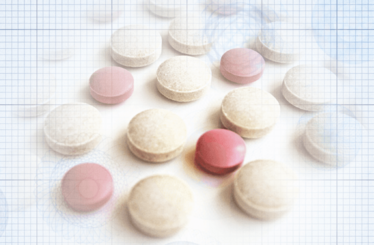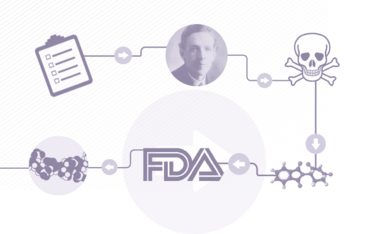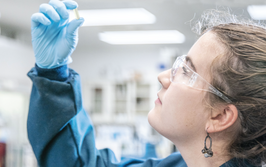
The Beginning of the End of Quality by Design
Where did Quality by Design come from? Where will it lead to in pharma? And is there a day when the concept will no longer exist?
Jasmine |

“Begin with the end in mind” is a very sensible principle for success in almost any aspect of life. In pharma manufacturing, this principle is encouraged by Quality by Design (QbD), which urges manufacturers to manage sources of potential variability in a process and to “get it right first time” when it comes to manufacturing. But when thinking about the quote “begin with the end in mind,” I was inspired to write this piece on QbD – and unlike many traditional best practices guides in this area I wanted to take a different angle by discussing the very beginnings of QbD, where it has ended up today and its ultimate ‘end’. Can there ever really be an end to QbD? Read on…
At this point, you may be asking why it is important to reflect on the past of QbD at all. The answer is clear – reflecting on the past allows us to understand a subject better, and to make improvements. Very early on in my career as a QbD practitioner and champion, I realized that understanding the history of quality is very important if we want QbD to become entrenched in the pharma industry. History teaches perspective and proportion, and I feel that both of these are lacking in the debate on how and why QbD will provide better drugs and healthier lives. In addition, an awareness of quality history reduces the risk of yesterday’s mistakes being repeated; in healthcare, mistakes can be fatal! So let me take you on a historical journey of the birth of QbD in the pharma industry. As fellow pharmaceutical professionals, I hope you find this fascinating – and I look forward to seeing how history inspires you and modern pharma.
Let there be quality
The beginnings of modern quality control can perhaps be traced to the mass-production manufacturing techniques that started during the industrial revolution. Large-scale manufacturing methods were further modulated by the demands associated with the two World Wars of the 20th Century; for example, the need for making large numbers of interchangeable parts for military equipment created more stringent requirements for precision and accuracy. Eventually, the lessons learned during this period filtered through into peacetime industry.
Even so, for many years most industrial processes assured quality by inspecting the end product only. But by the 1930s, a new approach to quality was apparent; notably, Walter Shewhart, an American engineer and statistician, shifted industrial emphasis from the quality of the final product to improving the process that creates the product. To this end, Shewhart advocated the use of engineering principles to build quality into the product, and introduced statistics for quality assurance purposes – in particular the measurement of variation as an indicator of process stability. Shewhart’s methods were espoused by Deming and Juran, his colleagues at Western Electric in Chicago (1).
While Shewhart brought the maths, Deming and Juran developed the management perspective on quality. They believed that quality improvement required, above all, management commitment and action; and that these, when effectively applied, motivated the workforce to attend to quality. Deming’s approach can be summarized as follows:
- emphasize the need for change
- institute firm leadershipreassure the workforce
- break down barriers between departments
- eliminate numerical targets and slogans
- promote continuing education
- eliminate the need for mass inspection by building quality into the product in the first instance, and continuous improvement of the production system.
According to Deming, a real improvement in quality was impossible without profound knowledge, which requires in-depth understanding of the following closely interrelated elements: systems approach, knowledge theory, variation analysis, and human psychology. In short, Deming proposed a systematic approach for continuous improvement, which balanced the technical aspects of quality with the human dimension (2).
Surprisingly, however, the US did not remember these lessons for long, and in the absence of competition, the US industry mistakenly came to believe that it had reached the ultimate stage in production and management systems. But at this time, in the eastern edge of the world, occupied post-war Japan desperately needed to reinvent its economy. The Union of Japanese Scientists and Engineers (JUSE) was formed in 1947 with the purpose of guiding Japan’s economic rebirth. Deming and Juran collaborated with JUSE to formidable effect, leading to the improved benchmarks of quality that we see in many of today’s industries. This period saw the emergence of influential quality leaders including Kaouru Ishikawa, Genichi Taguchi and Shigeo Shingo; these individuals, in association with JUSE, Deming and Juran, revolutionized Japan’s automobile industry by blending American theory and innovations with Japanese cultural influences and reinventions.
Contemporaneous developments in other industries included Fisher’s Design of Experiments (DoE) innovation in the UK, designed to optimize the potato yield in the UK’s post-war agriculture industry. DoE enabled experimental and observational inquiries to be conducted so as to maximize the information obtained for a given expenditure (3), and is now a common tool used in QbD-based product development. Similarly, the period just after the Second World War saw the insurance industry develop risk management systems to safeguard their own, as well as their customer’s interests. Risk management soon became another significant tool employed in QbD.
The effect of this systematic attention to quality soon became evident. In particular, Japanese industry became increasingly powerful, and by the 1970s, Japanese product quality had far surpassed that of America. The watershed event that would emphasize the increasing industrial competition that the US was facing from Japan – and catapult the theories of Deming and Juran back into American manufacturing – was a 1980 NBC television documentary titled, “If Japan Can, Why Can’t We?” (4). Following this, there was a renewed American focus on quality management, aided by individuals such as Armand V. Feigenbaum and Philip Crosby. Before long, improved concepts such as Six Sigma were developed.
There is a common thread to all these stories – namely, “needs to means”. Thus, over time, the evident need for quality assurance led to innovations with far-reaching consequences for industry: statistical process control by Shewhart, QbD by Juran; acceptance Sampling for the US military; design of experiments by Fisher; risk management by the insurance industry; the Toyota production system (now popularly known as lean management); quality circles in Japan; and Six Sigma in Motorola.
What about pharma?
The story of quality in pharma is also a “needs to means” tale – quality issues led to quality legislation, and quality legislation led to quality improvements. We now live in times when the stated regulatory goal is to create “a maximally efficient, agile, flexible pharmaceutical manufacturing sector that reliably produces high quality drugs without extensive regulatory oversight” (5) . It has been a long journey to reach this point, and the FDA is an interesting yardstick to use for understanding how system-based thinking has evolved within the regulatory bodies. A number of incidents have affected the FDA's regulation of (see Shaping Regulation Today) the drug industry, and hence influenced the development of quality legislation in the pharma sector (6).
Given that Juran trained the management of Takeda Pharma in quality systems in the 1950s – it is perhaps extraordinary that it took another fifty years before QbD really became the regulatory and then the industry’s choice. The systems approach visualized by Deming – i.e., the holistic view of industry operations as a system of interrelated processes, and the latter as sub-systems of interacting factors – was embodied in the FDA’s regulatory framework “Quality Systems Approach to Pharmaceutical cGMPs” and the ICH Q10 Guideline on “Pharmaceutical Quality Systems” – and then adopted by pharmaceuticals in the early 2000s. In its report on cGMP for the 21st century, the FDA identified particular aspects of pharmaceuticals manufacture that are incompatible with modern quality principles. In particular, the regulators asserted that (7):
- pharmaceutical processes are static
- the functionality of material characteristics in relation to process is not well understood
- out-of-specification values occur frequently
- measurement systems suffer from variability
- differentiation between inherent and special causes variability is difficult
- information needed for continuous improvement is segregated in different departments.
The FDA further endorsed QbD, as per the PAT Guideline (2004), the Process Validation Guideline (2011), and the Analytical Method Validation Guideline (2014). ICH’s Q8, 9, 10, 11 and the upcoming Q12 also are embodiments of patient-centric systematic development and manufacturing.

Shaping Regulation Today
A number of unfortunate events have contributed to the development of today’s drug regulation.
Publication of “The Jungle” in 1906
Upton Sinclair’s novel was written to expose the way immigrants were exploited in the US, but readers were more worried about the book’s description of the health violations and unsanitary practices of the American meatpacking industry. The book fostered the creation of the Pure Food and Drug Act, 1906, as well as a meat inspection law.
The Elixir Sulfanilamide incident in 1937
Sulfanilamide had been used safely in tablet and powder forms, but when the company, by popular demand, created an oral liquid form it resulted in many patient deaths, including a number of children, across the US. The liquid drug was not tested for toxicity because there was no law at the time that required safety studies. The incident accelerated the enactment of the 1938 Federal Food, Drug, and Cosmetic Act.
Thalidomide incident in the 1950s
Thalidomide was licensed in Germany in 1956 as an over-the counter sedative and became popular among pregnant women because it could help relieve morning sickness. In the following years, more than 10,000 children were born with disabilities. The disaster prompted the introduction of more stringent drug testing and licensing rules for drug safety and efficacy in a number of countries, including the US and the European Union.
Generic drug scandal in the late 1980s
Noting that its application to manufacture generic drugs was being repeatedly delayed, Mylan began to investigate the FDA. In 1989, a number of FDA officials pleaded guilty to accepting bribes from generic drug companies. It was also found that several manufacturers had submitted falsified data when looking to market their generic drugs. Dozens of drugs were suspended or recalled, and in the early 1990s, the FDA established the Office of Criminal Investigations (OCI).
Heparin adulteration in 2008
Following a number of deaths, and hundreds of adverse events, heparin manufactured in China on behalf of US pharmaceutical companies was found to be contaminated with oversulfated chondroitin sulfate (OSCS), which at the time was difficult to detect in the standard safety tests. The incident led to greater scrutiny over global supply chains and changes were also made to the heparin monograph in the US Pharmacopeia.
The End
In most industries, quality management tools are seen as a way to forge a closer connection with the consumer while also reducing variance and waste. The pharma industry, however, is perhaps the only industry making products that consumers often wouldn’t really “choose” to buy – in many cases consumers may not even be in a position to decide by themselves on their choice of product. At the same time, the difference between a good and bad quality product can be a matter of life and death for a consumer. As such, it is difficult for our industry to gauge customer satisfaction – and we must also admit that the potential for harm is not always easy to detect. All drugs are subject to highly stringent regulatory requirements and yet some unfortunate effects can still come to light after a drug has reached real-life patients. Safeguarding the consumer – the patient – is paramount in the drug industry. This is why we must embrace QbD, as well as lean manufacturing and Six Sigma. Modern quality systems like this help us to avoid medicine-related disasters of the past.
Change, however, is the only constant and today’s quality systems are challenged by the pressure for high volume, high quality manufacture, coupled with the need to reduce energy costs and carbon footprints. In addition, pharmaceutical manufacturing is being affected by the rise of personalized medicine (how do we manufacture them at a commercial scale?) and by changes in information technology and knowledge management (how do we make use of big data?).
There is still much to do so can we ever truly reach an “end” to QbD? One of my managers once told me that if I can make my job as the QbD champion cease to exist – i.e., if product development doesn’t need QbD proponents anymore – then I will have done my job well. In a way, that would be the “end” of QbD – when pharma doesn’t need to be reminded about developing and manufacturing products with the patient at heart. So when conferences and publications centered around QbD no longer exist, and when even articles like this are passé, the QbD story in pharma will have come to a happy ending. In many other industries it has almost reached that conclusion already – a Google Scholar alert with the search terms “Quality by Design” for many months now has affirmed my opinion that QbD at present is only pharma’s pet. And I hope we too soon evolve to make it a standard part of our way of developing and manufacturing better products.
I know there is a great deal more to be discussed – and in future articles I’ll be discussing lean Six Sigma tools in product development, capability building for QbD, the use and misuse of statistics in QbD, and risk assessments in product development.Jasmine is Principal Scientist, Quality by Design, at Dr. Reddy’s Laboratories SA. The views expressed are personal and do not necessarily reflect those of Jasmine’s employer or any other organization with which she is affiliated.
- M Best and D Neuhauser, “Walter A Shewhart, 1924, and the Hawthorne factory,” Qual. Saf. Health Care 15(2), 142–143 (2006).
- E Korakianiti and D Rekkas, “Statistical Thinking and Knowledge Management for Quality- Driven Design and Manufacturing in Pharmaceuticals,” Pharm. Res. 28(7), 1465–1479 (2011).
- RA Fisher, “Statistics” in Ed. AE Heath, “Scientific Thought in the Twentieth Century,” (1951).
- NBC News, “If Japan Can, Why Can’t We?” (June, 1980). bit.ly/1SJ5HyB
- FDA, Pharmaceutical Quality for the 21st Century (2002)
- BK. Immel, “A Brief History of the GMPs for Pharmaceuticals,” Pharmaceutical Technology (July, 2001).
- FDA, Pharmaceutical cGMPs for the 21st century – A Risk-Based Approach. Final Report (September, 2004).
Jasmine is a Principal Scientist, Quality by Design, at Dr. Reddy’s Laboratories SA


















